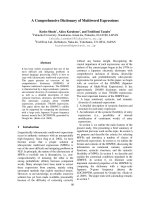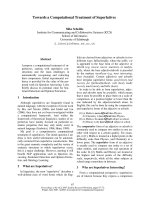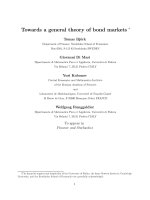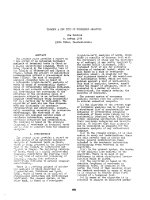Evolutionary Criminology Towards a Comprehensive Explanation of Crime
Bạn đang xem bản rút gọn của tài liệu. Xem và tải ngay bản đầy đủ của tài liệu tại đây (4.63 MB, 349 trang )
EVOLUTIONARY
CRIMINOLOGY
This page intentionally left blank
AMSTERDAM • BOSTON • HEIDELBERG • LONDON
NEW YORK • OXFORD • PARIS • SAN DIEGO
SAN FRANCISCO • SINGAPORE • SYDNEY • TOKYO
Academic Press is an imprint of Elsevier
EVOLUTIONARY
CRIMINOLOGY
TOWARDS A COMPREHENSIVE
EXPLANATION OF CRIME
Russil DuRRant
School of Social and Cultural Studies
Victoria University of Wellington
Wellington, New Zealand
tony WaRD
School of Psychology
Victoria University of Wellington
Wellington, New Zealand
Academic Press is an imprint of Elsevier
125 London Wall, London EC2Y 5AS, UK
525 B Street, Suite 1800, San Diego, CA 92101-4495, USA
225 Wyman Street, Waltham, MA 02451, USA
The Boulevard, Langford Lane, Kidlington, Oxford OX5 1GB, UK
Copyright © 2015 Elsevier Inc. All rights reserved.
This book and the individual contributions contained in it are protected under copyright by
the Publisher (other than as may be noted herein).
No part of this publication may be reproduced or transmitted in any form or by any means,
electronic or mechanical, including photocopying, recording, or any information storage
and retrieval system, without permission in writing from the publisher. Details on how to
seek permission, further information about the Publisher’s permissions policies and our
arrangements with organizations such as the Copyright Clearance Center and the Copyright
Licensing Agency, can be found at our website: www.elsevier.com/permissions.
Notices
Knowledge and best practice in this field are constantly changing. As new research and
experience broaden our understanding, changes in research methods, professional
practices, or medical treatment may become necessary.
Practitioners and researchers must always rely on their own experience and knowledge
in evaluating and using any information, methods, compounds, or experiments described
herein. In using such information or methods they should be mindful of their own safety
and the safety of others, including parties for whom they have a professional responsibility.
To the fullest extent of the law, neither the Publisher nor the authors, contributors, or
editors, assume any liability for any injury and/or damage to persons or property as a
matter of products liability, negligence or otherwise, or from any use or operation of any
methods, products, instructions, or ideas contained in the material herein.
Library of Congress Cataloging-in-Publication Data
A catalog record for this book is available from the Library of Congress
British Library Cataloguing-in-Publication Data
A catalogue record for this book is available from the British Library
ISBN: 978-0-12-397937-7
Publisher: Nikki Levy
Acquisition Editor: Nikki Levy
Editorial Project Manager: Barbara Makinster
Production Project Manager: Caroline Johnson
Designer: Matthew Limbert
Typeset by TNQ Books and Journals
www.tnq.co.in
Printed and bound in the United States of America
For information on all Academic Press publications
visit our website at />v
Contents
Preface ix
Acknowledgments xi
List of Figures xiii
List of Tables xv
1. Criminology and Evolutionary Theory
Introduction 1
The Subject Matter of Criminology 2
Evolutionary Explanations in Criminology 5
Why do Criminologists Largely Ignore Evolutionary Theory and Why Should
this Change? 11
An Overview of the Book 14
I
THE EVOLUTIONARY FRAMEWORK
2. Evolutionary Theory and Human Evolution
Introduction 21
Natural and Sexual Selection 23
The Modern Synthesis and Middle-Level Evolutionary Theories 26
The Extended Synthesis in Evolutionary Biology 30
Summary 32
Human Evolution 32
Summary 40
3. Evolutionary Behavioral Science
Introduction 41
Applying Evolutionary Theory to Human Behavior 42
The Critical Literature 52
Evaluation and Integration: Toward an Evolutionary Behavioral Science 57
Summary 65
CONTENTS
vi
4. Levels of Analysis and Explanations in Criminology
Introduction 67
The State of Criminological Theory 69
Levels of Analysis and Levels of Organization 73
Integration and Isolation 84
Summary 86
II
EXPLAINING CRIME
5. The Evolution of Altruism, Cooperation, and Punishment
Introduction 91
The Underlying Assumptions of Criminological Theories 93
Punishment 95
The Evolutionary Origins of Cooperation and Punishment 99
Proximate Mechanisms and Processes 107
Implications for Criminology and Criminal Justice 111
Summary and Conclusions 115
6. Distal Explanations: Adaptations and Phylogeny
Introduction 117
Key Explanatory Targets 118
The Evolution of Human Mating and Social Structure 121
The Evolutionary Origins of “Crime” 126
Aggression and Violence 130
Sexual Offending 146
Summary and Conclusions 151
7. Development
Introduction 153
Explanatory Targets for Developmental Criminology 154
Approaches to Explaining Developmental Patterns in Offending 160
Evolutionary Approaches 170
Summary and Conclusions 180
8. Proximate Explanations: Individuals, Situations, and
Social Processes
Introduction 183
Dynamic Risk Factors, Protective Factors, and Desistance 185
Agency Model of Risk 192
Research Implications 202
Conclusions 203
CONTENTS
vii
9. Social-Structural and Cultural Explanations
Introduction 205
Historical Trends 206
Ecological Variations in Crime 212
Theoretical Explanations for Ecological and Historical Variations in Crime 215
An Evolutionary Perspective 219
Summary 228
III
RESPONDING TO CRIME
10. Punishment, Public Policy, and Prevention
Introduction 231
Applied Evolutionary Criminology 232
Social and Situational Crime Prevention 234
Punishment and Restorative Justice 239
Wider Policy Implications 246
11. The Rehabilitation and Reintegration of Offenders
What is Offender Rehabilitation? 250
Evolutionary Explanatory Framework and Rehabilitation 251
Rehabilitation Implications 254
Example of Empathy and Altruism 262
Conclusions 270
12. Looking Forward from the Perspective of the Past
Integrative Pluralism: A Deeper Ontology 271
Embodiment 273
Emotion 274
Distributed Cognition 276
Conclusions 278
References 281
Index 325
This page intentionally left blank
ix
Preface
Our overall argument in this book is straightforward: we aim to make
the case that we can significantly advance our understanding of criminal
behavior and the way we respond to crime by drawing on the explana-
tory resources of evolutionary theory. Evolutionary explanations have
become increasingly prominent in many academic fields in the social and
behavioral sciences, but they have been largely ignored by criminologists.
We think that this neglect is unwarranted. Although an evolutionary
approach will not replace existing criminological theories—indeed, we
argue that it can be fruitfully integrated with extant approaches—it can
substantially enrich our understanding of criminological phenomena,
open up new lines of inquiry, and offer guidance on the most effective
ways of responding to crime. In short, we think that the arguments and
materials presented in this book will be of significant interest to crimi-
nologists, forensic psychologists, practitioners, and anyone interested in
understanding and managing criminal behavior.
Our overall aim may be straightforward, but providing satisfactory
explanations for any human behavior—including the subject matter of this
book, criminal behavior—entails rather more complexity. Humans are the
product of evolutionary processes and understanding those processes and
how they have shaped our psychological and behavioral characteristics
over millions of years is an essential part of the explanatory story. In this
respect we are much like any other species. However, we—unlike other
animals—also have a cultural history that has led to substantial changes
in the way that we live and the nature of our interactions with others, and
understanding this history and how it shapes our behavior is also cru-
cial. Humans also have a developmental history: our behavior, including
our propensity to commit crime, is influenced by the complex interplay
of genetic, epigenetic, and environmental processes that we experience
across the life course. Finally, we are embodied organisms with thoughts,
emotions, awareness, and a capacity for agency that allows us to make
choices that both shape and are shaped by the ecological, social, and cul-
tural environment in which we are embedded. Understanding the inter-
play of these various types of explanation, we argue, is a crucial task for
all social and behavioral scientists, and is essential for the development of
criminological theories.
In order to make sense of this complexity, we need to be armed with a
clear understanding of evolutionary theory, and how evolutionary expla-
nations relate to other types of explanations in criminology. This is the
PREFACE
x
primary task we tackle in the first part of this book. Inevitably some of
this material will be familiar to readers well versed in evolutionary biol-
ogy and evolutionary psychology, but we think it is important to provide
a clear overview of the key ideas and concepts. Moreover, there is a grow-
ing recognition of the importance of nongenetic inheritance in evolution-
ary processes and, more specifically, the role of culture and gene–culture
coevolutionary processes in human evolution. These ideas are central to
the arguments that are developed in this book, but may be less familiar to
many readers. In Chapter 4, we provide a framework, drawing in part from
Tinbergen’s (1963) idea that there are four types of explanations (those
that focus on evolutionary history, evolutionary function, development,
and proximate processes) that play complementary roles in explaining
behavior, that can help us to understand how evolutionary explanations
“fit in” with other types of explanations in criminology. With this evo-
lutionary framework in place, in Part II of the book we turn our atten-
tion to explanations of crime. In the five chapters that form the second
part of the book, we begin with an overview of evolutionary altruism and
cooperation, and then focus on each level of explanation in turn. In Part III
of the book we discuss how the approach that we have developed can pro-
vide guidance in our efforts to manage crime by looking at punishment,
prevention, and rehabilitation.
Understanding why individuals commit crime and how the propen-
sity to engage in crime varies across time and space is an important task,
for criminal behavior is responsible for a significant amount of harm in
society. Our responses to crime can also be the source of significant harm
and the overarching pragmatic goal of criminology and criminal justice
is to manage crime in ways that reduce the adverse effects associated
with it. In order to do this, we must be armed with the best explanatory
accounts that are available because attempts to intervene based on an
incorrect or incomplete understanding of the phenomena of interest are
likely to be ineffective. In recent years, biosocial criminologists have made
a persuasive case that criminology has neglected biological explanations
to its detriment and that the future of criminological theorizing will need
to recognize the complex interplay of biological and social processes in
the etiology of crime. The arguments that we advance in this book are
very much in the spirit of this claim. Although evolutionary explanations
barely feature in the education of criminologists, and this book, to the best
of our knowledge, is only the second authored monograph dedicated to
the topic of evolution and crime in the last decade, we believe that “evolu-
tionary criminology” holds much promise for advancing our explanations
of crime and how best to manage it.
Russil Durrant
Tony Ward
October, 2014
xi
Acknowledgments
We would first like to thank the editors at Academic Press for their
(patient) help and support with this book.
Russil Durrant would like to give special thanks to Carolina and Zoe
for their support and encouragement (with extra thanks to Zoe for all
your help on the references); Tony Ward for his unflagging enthusiasm for
this project and his stimulating academic support over the years. Thanks
also to my colleagues at the Institute of Criminology, and to Leo, Bea, and
Mavis for being there.
Tony Ward would like to thank Carolyn Wilshire and Alex Ward for
many stimulating conversations on theoretical issues and human behavior.
Thanks so much to Roxy Heffernan for helping me develop the Agency
Model of Risk. I would like to acknowledge the intellectual input from
Tony Beech and Richard Siegert over the years on evolutionary ideas.
Russil Durrant has been amazing to work with, a true scholar. Finally,
thanks to Leo (the very fluffy dog) for helping me unwind when I most
needed it!
This page intentionally left blank
xiii
List of Figures
Figure 2.1 Phylogeny of primates from 25 million years ago (mya) 34
Figure 3.1 An evolutionary taxonomy of within-group differences 62
Figure 3.2 An evolutionary taxonomy of between-group differences 62
Figure 4.1 The explanatory domain of criminology 71
Figure 4.2 A conceptual framework for organizing theoretical explanations 74
Figure 4.3 Levels of organization and levels of analysis for selected
criminological theories 79
Figure 5.1 The evolutionary outcomes of social behavior 102
Figure 5.2 The gene–culture coevolution of altruism, cooperation, and
punishment 105
Figure 5.3 Offending behavior in relation to our evolved capacity for
altruism, cooperation, and punishment 112
Figure 6.1 An evolutionary taxonomy of criminal behavior in relation
to adaptive design 128
Figure 7.1 Evolutionary developmental models for understanding
individual differences in antisocial and prosocial behavior:
The role of genetics and environment 174
Figure 7.2 Evolutionary developmental models for understanding
individual differences in antisocial and prosocial behavior:
Adaptive phenotypic plasticity 175
Figure 8.1 The agency model of risk (AMR) 193
Figure 8.2 Using the AMR to explain intimacy deficits 201
Figure 9.1 Mean homicide rates in European regions between 1200 and 2012
(excluding Corsica and Sardinia) 207
Figure 9.2 The ratio of male to female homicide perpetrators and
victims in London from 1300 to 1909 208
Figure 9.3 Homicide rates for selected countries (2012 or latest available) 212
This page intentionally left blank
xv
List of Tables
Table 1.1 The Representation of Evolutionary Theory and Other
Theoretical Approaches in Criminology Journals from
2000 to 2014 (Number of Articles) 8
Table 3.1 Criteria for Evaluating the Explanatory Value of Adaptation
Explanations 60
Table 4.1 Levels of Organization in the Social and Behavioral Sciences 75
Table 5.1 The Underlying Assumptions about Human Nature and
Their Roles in Criminological Theories 93
Table 5.2 The Nature of Punishment: What Needs to Be Explained? 96
Table 5.3 The Evolutionary Origins of Moral Foundations 106
Table 6.1 Key Explanatory Targets for the Distal Level of Explanation 120
Table 6.2 Reproductive and Social Traits of Hominids 122
Table 7.1 Key Explanatory Targets for the Developmental Level of
Explanation 155
Table 7.2 Risk Factors for Offending and Factors Relating to Desistance 158
Table 7.3 Life History Stages and Periods of Development in Humans
(and Chimpanzees) 171
Table 7.4 Faster and Slower Life Histories 176
Table 9.1 The Key Factors Identified by Eisner, Roth, and Pinker That
Can Account for Historical Changes in Violence 209
Table 9.2 Key Evolutionary Processes That Can Account for Historical
and Ecological Variation in Crime 222
This page intentionally left blank
Evolutionary Criminology
© 2015 Elsevier Inc. All rights reserved.
1
CHAPTER
1
Criminology and Evolutionary
Theory
INTRODUCTION
Depending on exactly when one wants to let off the starting gun, criminol-
ogy as an organized field of scholarly inquiry is no more than about 140 years
old (Godfrey, Lawrence, & Williams, 2008). The phenomenon of crime is,
of course, much older. How much older? The first codified laws of which
we have any detailed knowledge come from Babylonia around 1760 BCE,
so the origin of crime as “lawbreaking” dates from this period. All human
groups, however, set norms that prescribe acceptable behavior and mete out
punishment to those individuals who violate these norms (Boehm, 2012),
and the phenomena that are the primary foci of criminologists—violence,
rape, punishment, and the appropriation of resources from others—are
part of the “deep history” (Shryock & Smail, 2011) of humankind. In
their efforts to provide explanations for criminal behavior, criminologists,
forensic psychologists, and others largely focus on proximate factors such
as the psychological characteristics of offenders, their developmental his-
tory, and the social structure in which they are embedded. These types of
explanations are clearly important. They have proven valuable in the devel-
opment of theories and models of offending that have had some success in
both accounting for crime and guiding approaches to effectively managing
criminal behavior. We suggest, however, that our understanding of crime
and the way that we respond to it can be significantly enriched through a
consideration of the more distal causes of criminal behavior—those that
reside in the evolutionary history of our species. Moreover, a more com-
prehensive approach to understanding crime and responding to criminal
behavior, we claim, can be achieved through the integration of evolutionary
approaches with those that focus on more proximal causal factors.
In this book we make one—longish—argument for this approach. Our
aim in this opening chapter is more modest. We first clarify what we take
1. CRIMINOLOGY AND EVOLUTIONARY THEORY
2
as the core subject matter of criminology. Then we make the empirical case
that—despite the interdisciplinary aspirations of many criminologists—
mainstream criminology has almost completely neglected evolutionary
explanations in its attempts to understand the nature of crime and our
responses to it. We consider several possible reasons for this neglect and
suggest that the time is ripe for a careful consideration of how evolution-
ary approaches can be integrated within criminology. In the remainder of
the book we elaborate on and illustrate how this can be accomplished.
THE SUBJECT MATTER OF CRIMINOLOGY
Not all criminologists are in complete agreement about exactly what
discipline they are part of, and some argue that criminology should not
be considered an academic discipline at all (Garland, 2011). We suggest,
however, that criminology can reasonably be described as an applied
social and behavioral science. As such, criminology is organized around
a particular set of phenomena—very roughly, crime and our responses to
crime—rather than a specific level of analysis like sociology or psychology
(Agnew, 2011a). In this respect, criminology is somewhat like medicine—
an applied area of study undergirded by a number of basic sciences or aca-
demic disciplines. For criminology, the key areas of inquiry include—but
are not limited to—sociology, psychology, anthropology, political science,
history, and law. As we note below, some of these disciplines—notably
sociology—feature more prominently than others, and one of the main
aims of this book is to argue for a more thoroughgoing inclusion of evolu-
tionary biology into the field of criminology.
Even if we accept that criminology can be reasonably considered a
discipline in its own right, there remains some disagreement regarding
the scope of its domain, and criminologists have devoted a considerable
amount of energy to the task of defining just what constitutes “crime.” The
most straightforward approach, paraded in every introductory textbook, is
to define crime in legal terms: criminal acts are those that violate the crimi-
nal law and are therefore subject to sanction by the state. The major objec-
tion to this definition is that by defining crime in purely legal terms, the
subject matter of criminology becomes a moving target, as what constitutes
a criminal act varies both historically and cross-culturally. Many also argue
that this definition of crime is both too narrow and too broad: it excludes
many harmful acts while including many that result in relatively little or
no harm (Agnew, 2011a). In response to these objections (and others), many
criminologists prefer a definition of crime that is not yoked exclusively to
what is currently proscribed by the law, while others have suggested that
the focus on crime sensu stricto is a mistake and urge the acceptance of a
“crime-free criminology” (Gottfredson, 2011). Agnew (2011a, p. 187) argues
THE SUBJECT MATTER OF CRIMINOLOGY
3
for a more inclusive definition of crime that can be defined as “acts that
cause blameworthy harm, are condemned by the public, and/or are sanc-
tioned by the state.” We think that there is much merit in Agnew’s analysis.
A much simpler solution, however, is to accept that crime should be defined
in purely legal terms, but the subject matter of criminology includes more
than just crime. How much more? We suggest, largely consistent with
Agnew’s (2011a) approach, that criminologists should be concerned with
three overlapping kinds of phenomena:
1. Intentionally harmful acts;
2. Acts that violate consensually held social norms and are subject to
sanctions by group members; and
3. Acts that violate codified laws and are subject to punishment by the
state.
Most criminologists accept that harmful acts form a central component
of the subject matter of their discipline. Agnew suggests that the focus
should be on blameworthy harms, with harm defined as acts that violate
fundamental human rights. We think there is much value in this more
inclusive perspective on harm, but—consistent with our overall evolu-
tionary approach—suggest that intentionally harmful acts are those carried
out voluntarily that negatively affect the biological fitness of others. Murder is
the ultimate in intentionally harmful acts, because it entails the elimina-
tion of any further opportunities to promote reproductive success by the
victim. Many other acts also negatively affect biological fitness in lesser
ways. Bullying, verbal derogation, and sexual harassment, for instance,
may all reduce or limit the survival or reproductive opportunities of oth-
ers (e.g., through a reduction in status or reputation). This broad defini-
tion also encompasses the many harmful acts that have been the focus
of critical criminologists such as state-sponsored collective violence, dis-
crimination, corporate maleficence, and the failure to provide health care
to those in need. Acts that harm the environment or other species can also
be included here, as they have an impact on the biological fitness of other
species. Of course, some of these acts are going to be of more enduring
interest to criminologists than others (state-sponsored genocide under-
standably attracts more attention than the use of pesticides to eradicate
insect populations), and defining intentional harm in this way does not
necessarily imply that these acts are either morally wrong or that they
should be subject to sanctions by the state.
The second set of overlapping phenomena that we suggest should
form the subject matter of criminology concerns those acts that violate
consensually held social norms. These acts are largely those that Agnew
refers to in his definition as “condemned by the public.” There are two key
aspects to these acts. First, they violate consensually held social norms.
The importance of social norms for group cohesion and collective action is
1. CRIMINOLOGY AND EVOLUTIONARY THEORY
4
a recurring theme in this book and features prominently in evolutionary
approaches to understanding the nature of human cooperation (e.g.,
Bowles & Gintis, 2011; Richerson & Boyd, 2005; see Chapter 5). All human
groups have norms that are typically explicitly articulated and that pre-
scribe the domain of appropriate behavior. Many of these norms clearly
relate to intentionally harmful acts, but norms also regulate a wide class
of behaviors such as what food can be eaten and when, who is an appro-
priate marriage partner, and how individuals of different standing should
address one another. Second, these acts are subject to some form of sanc-
tion by group members—from verbal admonishments to social exclusion
and physical punishment.
The final set of acts that we suggest should form the subject matter
of criminology are those that violate the criminal law and are subject to
punishment by the state—in short, criminal acts.
Much of the subject matter of criminology concerns behaviors that are
intentionally harmful, violate consensually held norms, and break the
law. There are, however, important acts that fall into only one or two of
these classes of behavior and that, arguably, should also be of interest to
criminologists. The three sets of phenomena, when viewed through the
lens of evolutionary theory, also have a relatively clear history. Intention-
ally harmful acts are clearly the oldest class of behaviors in evolution-
ary terms and reflect the relentless logic of natural and sexual selection
(see Chapter 2), as organisms that manage to advance their own survival
and reproductive success at the expense of others are more likely to be
represented in subsequent generations. As such, intentionally harmful
acts predate the origin of our species and—given suitable license to the
term “intentional”—must have been present in the earliest organisms.
The second set of behaviors that form the subject matter of criminology
are, however, much more recent. Although some have argued that chim-
panzees have something like a sense of “social justice,” and a number of
species may “police” in-group behavior that threatens group functioning
(see Brosnan & de Waal, 2012; Clutton-Brock & Parker, 1995), the existence
of consciously articulated social norms is unique to our lineage, probably
emerging sometime around two million years ago (see Chapter 2). The
final set of acts is more recent still, because it relies on the emergence of
both writing (criminal acts are codified) and the state.
In sum, we suggest that the subject matter of criminology is largely
concerned with: (1) acts that are intentionally harmful, that violate con-
sensually held social norms, and/or violate codified laws and are sub-
ject to sanction by the state; (2) the consequences of these acts for others
(“victims”); and (3) responses to these acts in terms of punishment, preven-
tion, and rehabilitation. We appreciate that there are many criminologists
who would not be entirely satisfied with how we construe the field of crimi-
nology. Brisman (2012), for instance, contends that criminology is more than
EVOLUTIONARY EXPLANATIONS IN CRIMINOLOGY
5
the study of crime (even broadly construed) and responses to crime, and
suggests that we should also study—among other topics—“what crime
means to people” (p. 60) and what crime (and responses to crime) can tell us
about cultural values and social structures. Similarly, many criminologists
are interested in how crime and responses to crime are represented, with a
particular focus on the presentation and consumption of crime in the media
and what that can tell us about the nature of society. Inevitably, like most
academic disciplines, there will be no sharp lines that perfectly describe the
domain of criminology; inevitably there will also be topics of central and
more peripheral interest. Criminology may be more than the study of crime
(and harms and violations of norms) and our responses to crime (and how
that information can be deployed in real world contexts), but few would
deny—we think—that this is its central mission.
EVOLUTIONARY EXPLANATIONS IN CRIMINOLOGY
Many—perhaps most—criminologists are willing to accept that
criminology is, in principle, an interdisciplinary subject. McLaughlin and
Newburn (2010a, p. 2), for instance, assert that criminology is “a field of
inquiry where people from a variety of intellectual and scholarly back-
grounds come together to engage in research and deliberation.” Not all
would agree that this is the case in practice, despite the fairly widespread
existence of “integrative” approaches. Many criminologists, for instance, note
that criminological theory tends to be dominated by sociological approaches
(e.g., DeKeseredy, 2012). Some have noted the relative neglect and misrep-
resentation of psychological theories and approaches in criminology (e.g.,
McGuire, 2004; Webber, 2010), and we think it is fair to say that criminology
has not made as thorough use of contemporary psychological science in its
theorizing as it might have. Others draw attention to the failure of criminol-
ogy to fully incorporate biological approaches and argue that the adoption of
“biosocial criminology” will lead to a paradigm shift in criminology with
revolutionary consequences (Wright & Cullen, 2012). Although we think that
a paradigm shift in the strict Kuhnian sense is unlikely in the near future, we
are certainly in agreement that (1) criminology as a discipline has neglected
biological approaches, and (2) that the inclusion of these approaches would
significantly enrich our study of crime.
It is not uncommon for academics with a particular research interest
or theoretical orientation to lament the lack of interest in their favored
area of research, and there is always a temptation to overstate this neglect.
We think, however, that a fairly sound case can be made for the near invis-
ibility of evolutionary theory in mainstream criminology. We make this
case using three main sources of data: surveys of members of the American
Society of Criminology, textbook coverage of evolutionary approaches,
1. CRIMINOLOGY AND EVOLUTIONARY THEORY
6
and coverage of evolutionary approaches in leading criminology journals.
Evolutionary approaches have not been completely neglected, however,
and we follow the foregoing analysis with a brief historical overview of
evolutionary ideas in criminology.
In the following section we discuss reasons why evolutionary
approaches are relatively neglected and make the case that the time is ripe
for this oversight to be corrected.
The Neglect of Evolutionary Explanations in Criminology
In a study by Walsh & Ellis (2004), attendees at the 1997 American
Society of Criminology conference were sent a questionnaire that tapped
into their views concerning their favored criminological theory and the
most important causes of crime, along with a number of other questions.
The 147 respondents generated a list of 23 different theories with “social-
control,” “self-control,” and “differential association” the three most
favored approaches. Only one respondent selected an evolutionary
approach (“neo-Darwinism”). Respondents were also asked to rate a list
of 24 possible causes of “serious and persistent criminal behavior” in
terms of their importance on a scale ranging from 0 (of no importance)
to 9 (extremely important). Topping the list of causes were “unfair eco-
nomic system” (M = 6.29), “lack of empathy” (M = 6.14), and “lack of edu-
cational opportunities” (M = 6.08). “Evolutionary factors” were rated the
least important of the 23 causes (M = 1.37). In a replication of this study,
Cooper, Walsh, and Ellis (2010) sent questionnaires asking similar ques-
tions to all members of the American Society of Criminology having an
e-mail address in 2007. The 1218 respondents provided a roughly simi-
lar pattern of results as in the first study—at least with respect to their
views on evolutionary theory. No participant chose evolutionary theory
as the favored criminological theory (although it is notable that 21 did
select “biosocial theory”), and “evolutionary factors (natural selection)”
were again viewed as the least important in explaining criminal behavior
(M = 1.64). In sum, the results of these two studies suggest that Ameri-
can criminologists place almost no value on evolutionary approaches to
understanding criminal behavior, a result that is largely consistent with
the perceived importance of evolutionary approaches in the social sci-
ences more generally (e.g., Perry & Mace, 2010).
Another way of exploring the importance accorded evolutionary
approaches in criminology is to sample coverage of evolution and evolu-
tionary theory in criminology textbooks. Although textbooks necessarily
offer condensed and sometimes superficial coverage of topic areas, their
attention to particular theories and approaches is a useful indication of
what criminologists view as most important. Criminology is also blessed
with a relatively large number of textbooks, readers, and the like devoted
EVOLUTIONARY EXPLANATIONS IN CRIMINOLOGY
7
to criminological theory, and in principle these may provide the clearest
indication of the importance accorded by criminologists to different the-
oretical perspectives. In order to examine the coverage of evolutionary
theory in criminological textbooks, we took all introductory criminology
textbooks and textbooks, readers, and encyclopedias on criminological
theory published between 2000 and 2012 and held in the Victoria Uni-
versity of Wellington library as our sample. We then tabulated the num-
ber of indexed pages that referred to “evolution,” “evolutionary theory,”
“evolutionary psychology,” and related subjects—e.g., “evolutionary neu-
roandrogenic theory” and “sociobiology”—along with the actual amount of
text (in pages) devoted to these approaches. The final sample comprised 21
introductory criminology textbooks and 14 books devoted to criminologi-
cal theory (including the Encyclopedia of Criminological Theory).
The results revealed that a total of 21 books had some indexed ref-
erence to evolutionary approaches. In other words, 37 percent of all
introductory criminology textbooks and criminological theory books
published since 2000 and held in the Victoria University of Wellington
library had no indexed reference to evolutionary approaches at all. Over-
all, an average of just under two pages a book were devoted to evolu-
tionary approaches, representing 0.39 percent of the total pages in all of
the books analyzed. If we restrict our analysis to those books that did
mention evolutionary approaches, we find that on average just over three
pages were devoted to evolutionary approaches, representing 0.6 percent
of the total pages in those books. Only two books in the total sampled—
Walsh & Ellis (2006) and Marsh (2011)—devoted 10 or more pages to
evolutionary approaches.
The results of this study are fairly clear: introductory textbooks on
criminology and criminological theory largely ignore evolutionary
approaches. Coverage of evolutionary theory does, however, vary quite
a bit among the textbooks sampled. However, the fact that 37 percent of
the books had no indexed reference to evolutionary approaches suggests
that many criminologists believe that evolution simply has no place in
criminology. To put these results in perspective, it would be a major over-
sight if an introductory criminology or criminological theory textbook
had no coverage of, say, strain or social-control theory. Two recent books
on criminological theory provide good examples of the relative neglect
of evolutionary approaches. Akers & Sellers (2009) provide a 401-word
overview of criminological theories. The book includes the usual range of
theoretical approaches, including individual chapters devoted to “conflict
theory” “Marxism and critical theory,” and “feminist theory”; one chapter
is provided on biological approaches, with just under two pages allocated
to evolutionary theory. McLaughlin & Newburn (2010b) also provide a
detailed overview of major criminological theories (featuring chapters by
some of the key architects of criminological theory), and despite including
1. CRIMINOLOGY AND EVOLUTIONARY THEORY
8
13 chapters devoted to “new approaches,” there is no indexed reference to
evolutionary approaches at all. The main point of this exercise—we hasten
to add—is not to chastise the writers of criminological textbooks, as their
task is to reflect the state of play, not necessarily to set the agenda. How-
ever, it is clear that evolutionary theory does not feature prominently in
the kind of information that criminologists believe is important for stu-
dents to learn. Given that our sample is one of convenience, we also need
to note that the results of our analysis may not be representative of crimi-
nology textbooks in general.
A third way of exploring the coverage of evolutionary approaches in
criminology is to look at the representation of evolutionary ideas in lead-
ing criminology journals. To this end we examined all references to “evolu-
tionary theory” and “evolutionary psychology” (exact phrases) anywhere
in the text of articles published between 2000 and 2014 in three leading
criminology journals—Criminology, British Journal of Criminology, and
Theoretical Criminology. For comparison purposes, we also examined ref-
erences to other theoretical approaches in criminology, including “strain
theory,” “control theory,” “rational choice theory,” “cultural criminology,”
and “critical criminology” (exact phrases). As can been seen in Table 1.1,
the results of this analysis are fairly clear and largely support the idea
that evolutionary approaches have had a relatively limited role to play in
criminology as a discipline. Indeed, when the results of the three journals
are combined, we see that criminologists are 12 times more likely to refer
to either “control theory” or “critical criminology” than they are to evolu-
tionary theory.
To summarize, criminology as an academic discipline has neglected
the role of evolution in the development of explanations for criminal
behavior. We have perhaps belabored this point a little, and in our focus
TABLE 1.1 The Representation of Evolutionary Theory and Other Theoretical
Approaches in Criminology Journals from 2000 to 2014 (Number of Articles)
Criminology
British Journal
of Criminology
Theoretical
Criminology Total
Evolutionary theory 37 5 2 44
Evolutionary psychology 32 6 4 42
Strain theory 175 23 28 226
Control theory 497 31 21 549
Rational choice theory 144 37 17 198
Cultural criminology 251 55 73 379
Critical criminology 290 130 108 528









